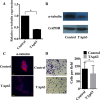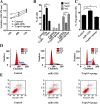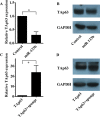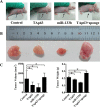Negative feedback between TAp63 and Mir-133b mediates colorectal cancer suppression
- PMID: 27894087
- PMCID: PMC5349978
- DOI: 10.18632/oncotarget.13515
Negative feedback between TAp63 and Mir-133b mediates colorectal cancer suppression
Abstract
Background: TAp63 is known as the most potent transcription activator and tumor suppressor. microRNAs (miRNAs) are increasingly recognized as essential components of the p63 pathway, mediating downstream post-transcriptional gene repression. The aim of present study was to investigate a negative feedback loop between TAp63 and miR-133b.
Results: Overexpression of TAp63 inhibited HCT-116 cell proliferation, apoptosis and invasion via miR-133b. Accordingly, miR-133b inhibited TAp63 expression through RhoA and its downstream pathways. Moreover, we demonstrated that TAp63/miR-133b could inhibit colorectal cancer proliferation and metastasis in vivo and vitro.
Materials and methods: We evaluated the correlation between TAp63 and miR-133b in HCT-116 cells and investigated the roles of the TAp63/miR-133b feedback loop in cell proliferation, apoptosis and metastasis via MTT, flow cytometry, Transwell, and nude mouse xenograft experiments. The expression of TAp63, miR-133b, RhoA, α-tubulin and Akt was assessed via qRT-PCR, western blot and immunofluorescence analyses. miR-133b target genes were identified through luciferase reporter assays.
Conclusions: miR-133b plays an important role in the anti-tumor effects of TAp63 in colorectal cancer. miR-133b may represent a tiemolecule between TAp63 and RhoA, forming a TAp63/miR-133b/RhoA negative feedback loop, which could significantly inhibit proliferation, apoptosis and metastasis.
Keywords: TAp63; metastasis; miR-133b; negative feedback; proliferation.
Conflict of interest statement
The authors declare no conflicts of interest.
Figures








Similar articles
-
TAp63 suppress metastasis via miR-133b in colon cancer cells.Br J Cancer. 2014 Apr 29;110(9):2310-20. doi: 10.1038/bjc.2014.118. Epub 2014 Mar 4. Br J Cancer. 2014. PMID: 24594999 Free PMC article.
-
MicroRNA-133b is regulated by TAp63 while no gene mutation is present in colorectal cancer.Oncol Rep. 2017 Mar;37(3):1646-1652. doi: 10.3892/or.2017.5371. Epub 2017 Jan 16. Oncol Rep. 2017. PMID: 28098895
-
The miR-124-p63 feedback loop modulates colorectal cancer growth.Oncotarget. 2017 Apr 25;8(17):29101-29115. doi: 10.18632/oncotarget.16248. Oncotarget. 2017. PMID: 28418858 Free PMC article.
-
miR-206/133b Cluster: A Weapon against Lung Cancer?Mol Ther Nucleic Acids. 2017 Sep 15;8:442-449. doi: 10.1016/j.omtn.2017.06.002. Epub 2017 Jun 7. Mol Ther Nucleic Acids. 2017. PMID: 28918043 Free PMC article. Review.
-
miR-133: A Suppressor of Cardiac Remodeling?Front Pharmacol. 2018 Aug 17;9:903. doi: 10.3389/fphar.2018.00903. eCollection 2018. Front Pharmacol. 2018. PMID: 30174600 Free PMC article. Review.
Cited by
-
Diagnostic and prognostic values of C‑X‑C motif chemokine ligand 3 in patients with colon cancer.Oncol Rep. 2019 Nov;42(5):1996-2008. doi: 10.3892/or.2019.7326. Epub 2019 Sep 19. Oncol Rep. 2019. PMID: 31545503 Free PMC article.
-
MiR-188-3p and miR-133b Suppress Cell Proliferation in Human Hepatocellular Carcinoma via Post-Transcriptional Suppression of NDRG1.Technol Cancer Res Treat. 2021 Jan-Dec;20:15330338211033074. doi: 10.1177/15330338211033074. Technol Cancer Res Treat. 2021. PMID: 34355586 Free PMC article.
-
Comprehensive analysis of differentially expressed profiles of lncRNAs and construction of miR-133b mediated ceRNA network in colorectal cancer.Oncotarget. 2017 Mar 28;8(13):21095-21105. doi: 10.18632/oncotarget.15045. Oncotarget. 2017. PMID: 28177879 Free PMC article.
-
Retraction Note: Long noncoding RNA LINC01234 promotes serine hydroxymethyltransferase 2 expression and proliferation by competitively binding miR-642a-5p in colon cancer.Cell Death Dis. 2023 Jul 11;14(7):412. doi: 10.1038/s41419-023-05943-5. Cell Death Dis. 2023. PMID: 37433780 Free PMC article. No abstract available.
-
HIPK4 accelerates cutaneous squamous cell carcinoma progression by phosphorylating TAp63 and inhibiting EFEMP1 expression.J Biol Chem. 2025 Jul;301(7):108564. doi: 10.1016/j.jbc.2025.108564. Epub 2025 Apr 30. J Biol Chem. 2025. PMID: 40316017 Free PMC article.
References
-
- Moll UM, Slade N. p63 and p73: roles in development and tumor formation. Mol Cancer Res. 2004;2:371–386. - PubMed
MeSH terms
Substances
LinkOut - more resources
Full Text Sources
Other Literature Sources
Medical

